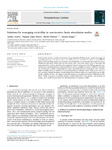Solutions for managing variability in non-invasive brain stimulation studies

Not available until 9999/99/99
Use this link to cite
http://hdl.handle.net/2183/35431Collections
- Investigación (CCDEF) [299]
Metadata
Show full item recordTitle
Solutions for managing variability in non-invasive brain stimulation studiesDate
2020-02-06Citation
Guerra, A., López-Alonso, V., Cheeran, B., Suppa, A. (2020). Solutions for managing variability in non-invasive brain stimulation studies. Neuroscience Letters, 719:133332.
Abstract
[Abstract] Introduction: In the last three decades, a number of non-invasive brain stimulation (NIBS) protocols, capable of assessing and
modulating plasticity in the human motor cortex (M1), have been described. For almost as long, NIBS has
delivered the tantalising prospect of non-invasive neuromodulation as a therapeutic intervention for neurorehabilitation,
psychiatry, chronic pain and other disease states. Apart from modest effects in depression, this
early promise has not been realised since the symptomatic improvements produced by NIBS are generally weak.
One key factor explaining this lack of clinical translation concerns variability in response to NIBS. Several studies
have demonstrated a number of physiological, technical and statistical factors accounting for intra- and intersubject
variability. However, solutions to overcome this problem are still under debate. In the present review, we
have provided a detailed description of methodological and technical solutions to control known factors influencing
variability. We have also suggested potential strategies to strengthen and stabilize NIBS-induced aftereffects.
Finally, we propose new possible outcome variables which better reflect intrinsic cortical activity, allowing
a more sensitive measurement and valid interpretation of responses to NIBS.
Keywords
Non-invasive brain stimulation
Transcranial magnetic stimulation
Theta burst stimulation
Paired associative stimulation
Transcranial direct current stimulation
Variability
Transcranial magnetic stimulation
Theta burst stimulation
Paired associative stimulation
Transcranial direct current stimulation
Variability
Editor version
Rights
© Elsevier
ISSN
0304-3940
Related items
Showing items related by title, author, creator and subject.
-
Variability in non-invasive brain stimulation studies: Reasons and results
López-Alonso, Virginia; Guerra, Andrea; Cheeran, Binith; Suppa, Antonio (Elsevier, 2020-02-06)[Abstract]: Introduction: Non-invasive brain stimulation techniques (NIBS), such as Theta Burst Stimulation (TBS), Paired Associative Stimulation (PAS) and transcranial Direct Current Stimulation (tDCS), are widely used ... -
A preliminary comparison of motor learning across different non-invasive brain stimulation paradigms shows no consistent modulations
López-Alonso, Virginia; Fernández-del-Olmo, Miguel; Cheeran, Binith; Sandrini, Marco; Abe, Mitsunari; Cohen, Leonardo; Liew, Sook Lei (Fronteirs, 2018-04-23)[Abstract]: Non-invasive brain stimulation (NIBS) has been widely explored as a way to safely modulate brain activity and alter human performance for nearly three decades. Research using NIBS has grown exponentially ... -
Efectividad de la estimulación eléctrica neuromuscular y la estimulación cerebral no invasiva en el tratamiento de la disfagia post accidente cerebral vascular en las fases aguda o subaguda: una revisión de la literatura
Vázquez Ramil, Inés (2020-06)[Resumen] Introducción. La disfagia es un trastorno que ocurre como una complicación en el 37-78% de los pacientes con accidente cerebrovascular (ACV) y da lugar a problemas graves como la malnutrición, deshidratación, ...





